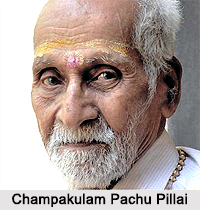 Champakulam Pachu Pillai was an eminent Kathakali exponent. He was a specialist in the category of tati or bearded roles.
Champakulam Pachu Pillai was an eminent Kathakali exponent. He was a specialist in the category of tati or bearded roles.
Early Life of Champakulam Pachu Pillai
Champakulam Pachu Pillai was born to a family of artistes in the Perumanur household of Champakulam in Alappuzha district in 1907. Champakulam Pachu Pillai was the elder brother of Gopi Nath. His maternal uncle, the Kathakali actor Champakulam Sanku Pillai, trained him from the age of 14. Champakulam Pachu Pillai started his studies in Kathakali at the age of 14 under Champakulam Paramu Pillai. After completing a rigorous dance course, Champakulam Pachu Pillai joined the Mathoor and Thakazhi Kathakali Yogam.
The legendary Kathakali guru Vechoor Ramu Pillai inspired him to specialize in `Thadi` types of characters. Thereafter Champakulam Pachu Pillai won recognition as a brilliant artiste in the Thadi or bearded roles.
Career of Champakulam Pachu Pillai
Champakulam Pachu Pillai began his career as Krishna in Rukmini svayamvaram i.e. `Rukmini`s Choice of Groom`. The Thakazhi and Mathur troupes accepted him as a member, giving him important roles because of his extraordinary height, large expressive eyes, well-built body, deep and penetrating voice, and extremely fearful visages that fitted the requirements of antagonists. The famous tati exponent, Vechur Raman Pillai regarded Champakulam Pachu Pillai as his favourite disciple and encouraged him to specialize in tati. As his guru advised and predicted, he became very famous in the villainous chuvanna tati or red beard roles of Bali, Sugriva, Trigarta, Dussasana, Dwapara, Upakichaka, Virabhadra, and Jarasandha. The primitive karutta tati or black beard characters of the Kirata hunter and Kali, and the vellattati or white beard divine animals like Hanuman. Champakulam Pachu Pillai also excelled as Narasimha and as kari or black demonesses like Nakratundi and Simhika. Champakulam Pachu Pillai was appointed as dancer in the Travancore senior palace troupe in 1939. He continued to act his favourite roles till the age of 84 with the vigour and enthusiasm of his youth. Champakulam Pachu Pillai won respect for his simplicity and as a friend to all who knew him.
Awards Received by Champakulam Pachu Pillai
•Champakulam Pachu Pillai was honoured with Kerala Sangeetha Nataka Akademi Award in 1969.
•Champakulam Pachu Pillai was honoured with Kerala Kalamandalam Award in 1991
•Champakulam Pachu Pillai was honoured with Sangeet Natak Akademi Award in 1983.



















